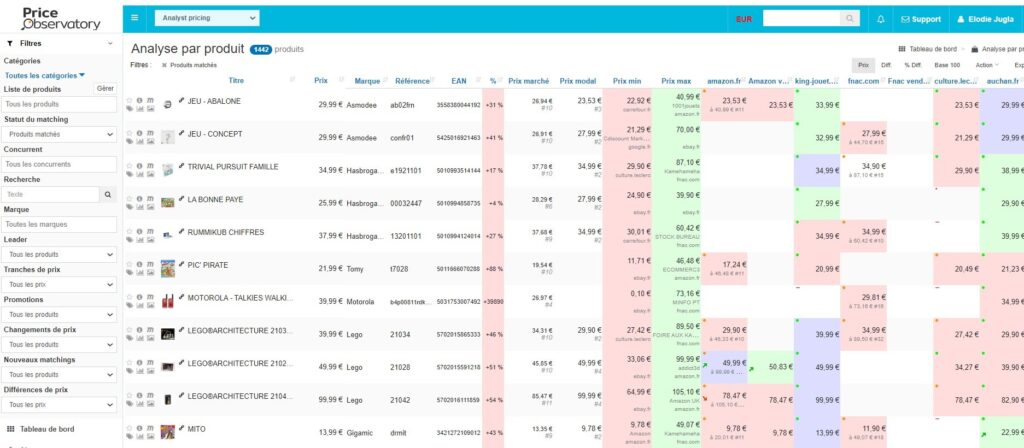The impact of seasonality on pricing is a major challenge for businesses, especially when you consider that half of the promotions do not generate any increase in sales.
This is because a successful business relies heavily on the balance between pricing, promotions, and inventory management. Thus, price monitoring becomes an essential tool for anticipating and adapting to seasonal variations.
This approach not only optimizes your prices according to market demand, but also improves your competitive positioning.
In this guide, you'll learn how to effectively use price intelligence to anticipate seasonal variations and optimize your pricing strategy. We go through the essential tools as well as best practices to monitor prices effectively.
Understanding Seasonal Rate Watch
Seasonal price monitoring is a permanent price monitoring system that takes into account periodic market fluctuations. This methodical approach allows companies to analyze and anticipate price changes throughout the year.
In addition to being able to track competitors' prices, this marketing technique also allows you to control the pricing applied by distributors to their own products.
The main objectives of this approach are multiple:
- Accurate real-time market analysis
- Identifying pricing trends
- Strategic price adjustment to maintain competitiveness
- Optimizing sales margins
The different types of seasonal variations
Seasonal variations occur in a predictable and cyclical manner, affecting each industry differently.
These fluctuations are characterized by several distinct components:
- The trend-cycle: it reflects the fundamental variations over a long period.
- The seasonal component: it corresponds to the fluctuations that are repeated annually.
- Calendar effects: they take into account the impact of working days
- The irregular component: it includes residual fluctuations.
To measure these variations and adjust their pricing strategies accordingly, companies use the seasonal coefficient, which is obtained by comparing the average sales of a period to the theoretical average of the quarters or months of the year.
More specifically, this analysis makes it possible to:
- Knowing precisely the weight of a quarter's sales in annual turnover
- Plan actions to adjust seasonal sales
- Set up targeted promotions
- Diversify products during periods of low activity
Impact of seasonality on prices
Seasonal price variations affect many industries, creating predictable cycles that directly influence business strategies. The magnitude and nature of seasonal variations depend on several sectoral factors.
In tourism and hospitality, prices soar in summer for seaside resorts and in winter for ski resorts. Property prices rise systematically in the 2nd and 3rd quarters, with a more marked increase for houses than for apartments. Seasonalrentals, on the other hand, are subject to strong fluctuations in cities dependent on seasonality such as Cannes or Megève.
Agriculture and agri-food see their prices change according to harvests and weather conditions, while the energy sector sees price increases in winter for gas and in summer for electricity, in response to heating and cooling needs.
As far as the retail trade is concerned, according to INSEE, toy sales generally increase significantly between November and December due to the end-of-year celebrations. Some products, on the other hand, such as winter clothing, have big discounts out of season. These variations may also differ between countries and economies, depending on the relative weight of sectors of activity in their economic structure. The health crisis has also changed certain traditional seasonalities, particularly in the transport and tourism sectors.
Essential tools for price intelligence
To meet the challenges of price seasonality, professionals now have sophisticated tools at their disposal for precise market monitoring.
Price tracking software
Among the most useful are price tracking software. These modern price intelligence solutions automate data collection and analysis.
Price Observatory is among the best competitive intelligence software. It extracts prices, promotions and stocks from competing sites on a daily basis and allows real-time monitoring of prices on all their merchant sites.
This type of pricing tool offers several essential features:
- Automatic detection of price changes
- Analysis of market trends
- Tracking competitor promotions
- Identification of tariff adjustment opportunities

Competitive intelligence tables
The competitive intelligence board is another price tracking tool that offers clear visualizations of price positioning across different charts and curves. In particular, it allows you to:
- Compare prices with competitors
- Analyze market availability
- Follow the evolution of prices according to the periods
The frequency of surveys can be adjusted according to seasonal needs. For example, once a month in low season and once a week in high season. Custom alerts can also be set up to flag significant price changes at competitors.
To maximize their effectiveness, it is essential to choose your competitive intelligence tools carefully and integrate them with your existing management systems. Thus, price intelligence data can be directly connected to ERP, CRM or quoting software. This interconnection makes it possible to automate price adjustments and improve responsiveness to market variations.matiser les ajustements de prix et d'améliorer la réactivité face aux variations du marché.
Implement an effective strategy
An effective price monitoring strategy requires a methodical approach and the right tools to anticipate seasonal price variations.
The first step is to precisely identify your key competitors and products to look out for. Modern tools make it possible to track thousands of brands and retailers simultaneously.
To obtain relevant results, it is essential to compare similar elements:
- Prices including VAT or excluding VAT
- Shipping costs included or not
- Associated services
- Sliding scale prices for B2B sites

Choosing the right metrics
Four main indicators can be used to optimise your price monitoring:
- The average price of the product over time
- Overall market behaviour
- The characteristics of competing companies
- Temporal and seasonal dimensions
This is because analyzing historical pricing data helps identify trends and predict future price fluctuations.
In addition, the monitoring of raw material and logistics costs has a direct influence on the pricing strategy. This approach is essential to ensure effective business intelligence .esoins and its internal resources to take full advantage of competitive data.
Automate data collection
Automation is an essential element for effective monitoring. A price tracking tool analyzes product pages in real time and automatically matches SKUs.
This automation is based on:
- Barcodes (GTIN, EAN, UPC)
- Supplier references
- Image recognition
To ensure the reliability of the data, a similarity score is calculated for each match. This approach provides accurate, real-time analysis of the market, while preserving margins.
The implementation of an effective price watch also requires cross-referencing price data with quantitative (stock, distribution) and qualitative (customer reviews, merchandising) aspects. This global approach allows you to adjust your pricing strategy in a more relevant way in the face of seasonal variations.es.
Conclusion
Price monitoring is a real strategic tool in the face of seasonal price variations.
The data shows that companies that incorporate a seasonal coefficient calculation into their strategy benefit from better anticipation of market fluctuations while maintaining their competitiveness.
Modern price intelligence tools, such as competitive intelligence software and competitive intelligence tables, combined with a rigorous methodology, offer concrete solutions to manage these variations.
The success of a price intelligence strategy is ultimately based on three essential pillars: the precise definition of the monitoring perimeter, the judicious choice of indicators and the automation of processes.
Discover Price Observatory, the price monitoring software that allows you to monitor your competitors in real time, analyze market trends and adjust your prices optimally! Thus, you will ensure effective commercial monitoring by adapting to seasonal cycles while preserving your margins.
